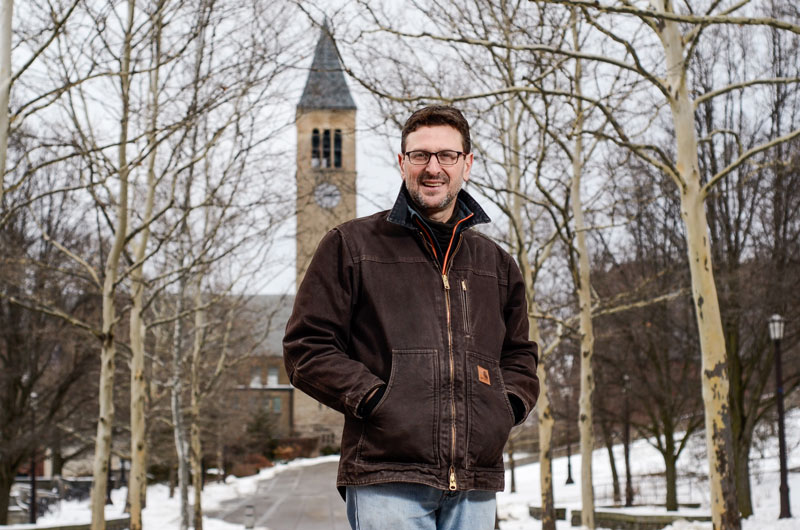
Frank Rossi, Ph.D., the winner of GCSAA’s 2018 President’s Award for Environmental Stewardship, in front of Cornell University’s iconic McGraw Tower. Photo by Heather Ainsworth
Frank Rossi, Ph.D., the 2018 recipient of GCSAA’s President’s Award for Environmental Stewardship, isn’t merely the intellectual force behind several of the more environmentally conscious concepts embraced by the turf industry. He also knows how the sausage is made, and it’s exactly this on-the-ground understanding — of the turfgrass management profession and of prize kunekune pigs, among other things — that gives his broader views on environmental stewardship, sustainability and best management practices a unique brand of authority.
Turfgrass research as it relates to the golf course industry has never been monolithic, but over the past 40 years, it has been dominated by mainstream academics and institutions that identify golf-specific issues and seek to overcome them via practices that, more often than not, rely on chemical inputs.
“We work in a product business. Our reaction to disease and trouble has always been, ‘What product will take me out of this?’” says Jeff Carlson, the former superintendent at Vineyard Golf Club and Widow’s Walk Golf Course, two Massachusetts properties that stand as landmarks in the sustainable turf movement Rossi helped create. “You see something, you decide how to best combat it, then you go out and spray for it. I’ve found that managing without the benefit of pesticides changes your whole perspective.”
Rossi has been integral in developing that perspective. Which is not to say that he is some kind of agronomic bomb-thrower. The security of a traditional university/research position may have allowed for that sort of radical opposition, but Rossi has never walked that path. From his days as a working golf course manager to his undergraduate studies at the University of Rhode Island to his position today as an associate professor of turfgrass science and Extension turfgrass specialist at Cornell University’s School of Integrative Plant Science, Rossi has developed and couched his views in the practical.
Indeed, Rossi’s Extension work has been central to this approach. Not all academics get out there — on the ground, in the trenches — and interact directly with such a wide variety of golf course superintendents and land managers. For 30 years, Rossi has reveled in this responsibility, in the same way he has stayed abreast of the research conducted by his academic colleagues.
“Frank’s a forward thinker,” says Norm Hummel, Ph.D., Rossi’s former colleague at Cornell and today a distinguished turf academic and consultant in his own right. “He really gets into the research — not just his own, but that done by others — and that has always impressed me. He’s always really current about what is going on, and he formulates his own opinions based on that. Sometimes people disagree, and that generates some controversy. But that’s what makes him a leader in the field.”
What sets Rossi and his life’s work apart — from giving intellectual heft to terms like “stewardship,” “sustainability” and “best management practices” to riding herd with his colleague Jennifer Grant, Ph.D., on 13 years’ worth of groundbreaking study at Bethpage State Park on Long Island — is this practical emphasis on the day-to-day work of superintendents. This, his colleagues agree, is a function of Rossi’s diligence, but is also the nature of Extension work.
Of course, Extension work also places an emphasis on communicating these everyday solutions and strategies, which again plays to Rossi’s strengths. Good luck finding a more engaging and verbose member of the turf science establishment.
“I study turf, but if you look at my career, it’s almost like I study superintendents,” says Rossi. “The goal of my research has always been to apply the rigorous scientific method to practical problems in turfgrass management, the specific areas of reduced fertilizer and pesticide use. And I do maintain a strong problem-solving focus in my Extension program, with particular emphasis on increased resource efficiency and improved environmental compatibility.
“That’s a message not just for superintendents, but for golfers as well. The other part of my career has really been about trying to educate golfers as to what is happening in this business, because superintendents have always had this environmental focus. But an informed golfer today will also demand that sort of environmental stewardship from superintendents. I now look at turf as just another aspect of land management, crop production and soil management. Golf was my entry, but that has led quite naturally to my interest in farming. It’s funny how your career evolves.”
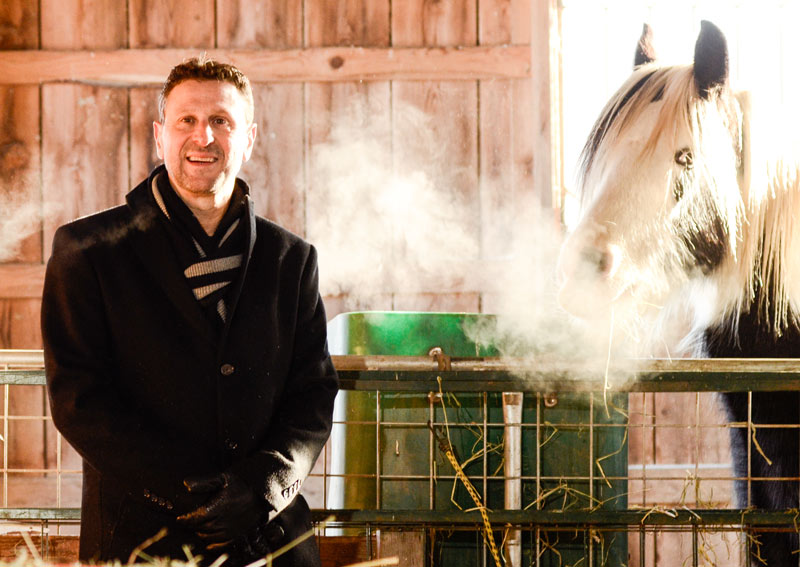
A native New Yorker, Rossi has found contentment in the rural lifestyle of upstate New York on Bel Canto Farm, where he and his wife, Barbara, live and run an active kunekune pig breeding operation, in addition to raising a host of other livestock. Photo by Heather Ainsworth
A porcine representative from Rossi’s Bel Canto Farm in Trumansburg, N.Y., is not expected to be on hand Tuesday, Feb. 6, when he officially receives the President’s Award during the GCSAA Opening Night Celebration at the 2018 Golf Industry Show in San Antonio. Without that distraction, those in attendance will be obliged to sit back and appreciate the enormous legacy Rossi, just 55, has already accrued.
“What will Frank be remembered for?” asks Micah Woods, Ph.D., a Rossi protégé at Cornell and today the head of the Asian Turfgrass Center in Thailand. “It has to be his personality and his teaching, all the people that he’s influenced, and getting people to think differently about what they’re doing. Sustainability is a big part of that, but he’s just influenced so many people in so many different areas.”
According to Tim Moraghan, former USGA agronomist and now head of Aspire Consulting, “When I’m at a conference and Frank is speaking, I always make the time. I first met him in 2002 at Bethpage, just after he started the dollar spot research on the Green Course. Everyone was busting his chops back then. I stood up and said, ‘Hey, you got a pretty smart guy here who has done a lot of good research. You might want to take 15 minutes to see what he’s about.’ I think he has done an awful lot to bring an environmental consciousness to golf when it really needed it.”
Of course, the ability to communicate, while a virtue unto itself, is greatly enhanced by relevant messaging delivered in a timely manner. Here, Rossi has consistently been ahead of his time.
Green acres
Bel Canto Farm, operated by Rossi’s wife, Barbara, is an idyllic 50-acre spread located some 20 minutes west of Cornell, which sits at the southern tip of Lake Cayuga, one of New York State’s famed Finger Lakes. Some city folk can’t imagine a life outside the urban realm. Rossi is not one of them.
Born and raised in New York City, his life was transformed by a summer camp experience on Long Island Sound. As a teenager, he sought greener pastures by working on the crew for several Westchester County golf courses, in addition to a landscape installation and maintenance outfit. He would first attend SUNY Cobleskill as a dairy farm management major, but quickly switched to agronomy. He would earn bachelor’s and master’s degrees at the University of Rhode Island before earning his Ph.D. in plant science from Cornell.
Rossi came pretty close to becoming a superintendent himself. Throughout his time at Rhode Island, he served as an assistant at Greenwich Country Club, and he even did a short stint as course manager at a small nine-hole course, Wildfield Links.
“I wanted to be superintendent, but the closer I got to that sort of job, it became clear to me that superintendents deal with a very demanding clientele — and there wasn’t necessarily a straightforward way to please that clientele,” Rossi recalls. “I didn’t like that moving target that golfers put on superintendents sometimes. I liked the idea of golf courses, but I discovered I had more intellectual interests — the study of it versus the practice of it. So I went back to grad school, and I made it my business to study superintendents, the decisions they make, and how we influence them to get what they want and deliver to clients what they want.
“And I have to be honest: I think that most supers have something I don’t have — the ability to keep their mouth shut. I would have had a difficult time as a superintendent faced with irrational expectations. I continue to have a difficult time with those. What I’d rather do is support guys in the face of those expectations.”
Some 15 years ago, with three young children, Barbara Rossi decided to devote her time to raising their kids and farming. Leveraging equity in their Trumansburg home, the couple built a barn and spent four years developing a breeding enterprise. Soon they added heritage-breed pigs and some 40 additional acres — 5 of those fenced pastureland, another 10 for hay.
“And, of course, my wife needed a horse,” Rossi says. “She was looking to do something on a small scale but has since become one of the top breeders (of kunekune pigs) in the country. We have a pretty active breeding and pork operation now. We do some agritourism, sell some hay, a bit of garlic and eggs.
“Again, it’s funny how your life evolves. I like studying the environment and I like studying fast putting greens. Two opposite ends of the spectrum, if you think about it. I feel very lucky to have come along as I did, when I did, to have found this stuff — and the love of this work.”
Practical passion
Rossi’s academic passion for turfgrass got off to a traditional start. Upon earning his doctorate from Cornell, he moved west to Lansing, Mich., where he spent two years as an environmental education specialist at Michigan State University. He would eventually find his way back to Ithaca, starting in 1996, but in between he spent four productive, provocative years at the University of Wisconsin as an assistant professor focused on the environmental management of turfgrass. He also served as the Wisconsin Extension turfgrass specialist.
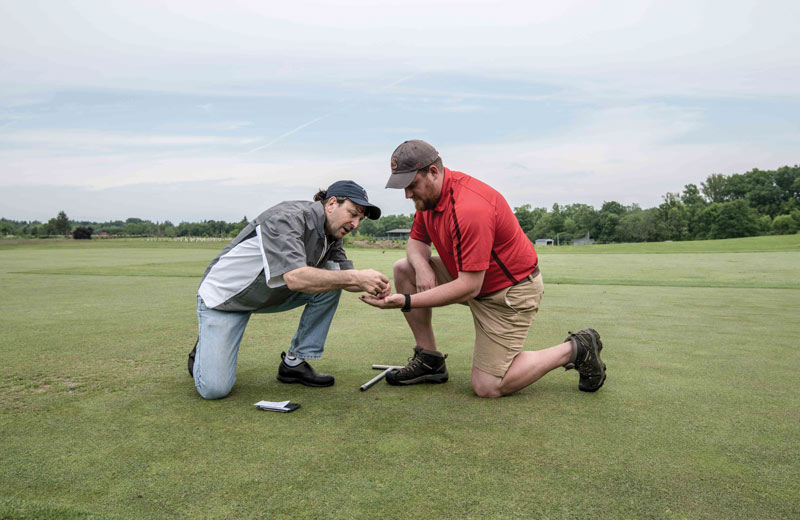
Rossi embraces what he terms “the study of superintendents,” and dedicates himself to getting into the field through his role in Cornell’s Extension program. He was an early adopter of sustainable ideas in golf course management, encouraging superintendents to consider practices that reduce inputs and water use. Photo courtesy of Cornell University
It was in Wisconsin that Rossi first developed his reputation as an outspoken questioner of the status quo. See here an excerpt from “Visions of Sustainability,” an article that appeared in The Grass Roots, a publication of the Wisconsin GCSA, in the winter of 1993:
“I want to use my ‘gazing space’ this issue on a discussion of sustainability (a concept which will shortly become as overused as the term Integrated Pest Management) ... If one stops and listens closely, you can hear the winds of change blowing our way. It is my opinion that we cannot sustain our golf courses with energy-intensive management inputs which alter the ecological balance (e.g., pest resistance, earthworm and ant control). Additionally, many of the practices we employ to satisfy the golfer deeply concern a large proportion of our society. I admit this may sound like radical thinking, but I believe that reducing management inputs while maintaining a level of quality which the golfer demands is a viable goal. How do we get there?”
It would be difficult to overstate the importance of this very public, very contrarian statement of purpose. It was not peer-reviewed research, but it nevertheless struck a chord. And Rossi was right — almost from the moment this issue of The Grass Roots was distributed, the term “sustainability” did become a buzzword — probably overused, but throughout the 1990s and much of the 2000s, surely controversial. This idea of sustainability in the golf course maintenance context, of “doing more with less,” was new. It would attach itself to Rossi and nearly all of his work going forward. Eventually, the entire golf industry would adopt it, but plenty of kicking and screaming went down in the meantime.
“My name was out there because I talked a lot about the work I do. I’ve been criticized for that, whether it’s sustainability or reducing fertilizer use or being smarter about water use,” Rossi says. “But I do think it comes down to, ‘If I’m going to try this product, which product do I eliminate? What inputs do I eliminate if I try this?’
“At the time, I think one could argue this was a sideways view compared to those coming out of other big turf schools. Not to be critical of them, but the big schools went in for industrial turf management in a big way, and I’ve always felt that I was swimming against that tide — until 2009.”
What’s so important about 2009?
“To be honest, if the golf economy didn’t crash in 2009, there would have been far less interest in sustainability. The new economics in golf made it make sense. It would not have gotten the same attention if so much money didn’t go out of the business.”
Steve Mona, who served as GCSAA’s CEO from 1994 to 2008, and today is head of the World Golf Foundation, agrees. “Frank was certainly ahead of his time as it relates to sustainability. For people like that, who are ahead of their time, it generally does require something dramatic to make the rest of the industry catch up — it may very well have taken a recession in this case.”
Bethpage breakthrough
If Rossi and Mona are correct, the tide turned at a very opportune time, because Rossi’s signature bit of research, the Bethpage Project, was already underway in 2009, and wouldn’t conclude until 2014.
It was 2000 when Rossi and Grant, the coordinator for the New York Community IPM Program at Cornell, proposed a study to the USGA to evaluate reduced and non-chemical management of putting greens. Despite Rossi’s public views, minimizing inputs was still a maverick idea at that time, but the project did come as a result of increased pesticide bans and restrictions that had already taken hold in the state of New York.
The first goal of the project was to develop putting green management systems that would reduce reliance on synthetic chemical pesticides. The second goal was to demonstrate the impact of a pesticide ban on golf turf performance. The project was conducted as a systems-based approach to develop a more efficient use of pesticides while emphasizing cultural practices.
The findings revealed few differences in turf quality and ball roll between integrated pest management and standard, chemically managed greens. But they also revealed that turf quality and championship conditions will suffer with no chemical pesticides in certain climates, hardly an indictment of inputs. In any case, the project and its findings (Reducing Chemical Use on Golf Course Turf: Redefining IPM) were later developed into an educational manual that was translated into Spanish and has since been distributed and consumed worldwide.
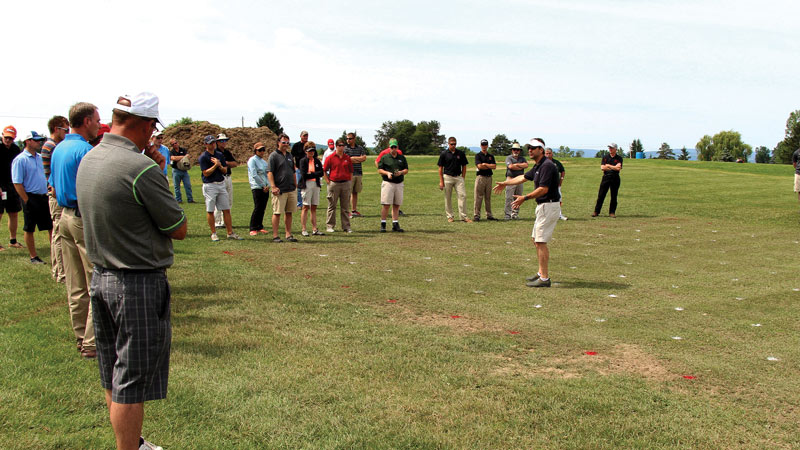
Among Rossi’s fieldwork over the years is the Bethpage Project, a signature study he conducted with another Cornell professor, Jennifer Grant, Ph.D., that examined the effects of reduced and non-chemical management on putting greens. Photo courtesy of Cornell University
“Again, the Bethpage project would not have gotten such attention if the money hadn’t gone out of the business,” Rossi says. “Today it makes sense, because you can now market your environmental stuff alongside playability and appeal to golfers, who are quite different than they were 20 years ago. But at the time (prior to 2009), I understood the pushback. When I started talking about eliminating potassium in turf programs, in the 1990s, I would go around and speak and guys would get pissed off. ‘How do you know?’ they would say. When you challenge a fundamental part of a superintendent’s program, it can cast a negative light.
“I don’t think I make waves. Not purposely. I think if you are headed west, there are a dozen different ways to get there. But maybe I am a bit of an agitator. And I do get out there a lot, to speak. But I think a researcher should question things, all the time. Continuous improvement, right? That’s the part of science and research that suits me quite well, it turns out. But it wasn’t always popular. If you ask 10 guys today, I’m sure there are still two to three who still think I’m a jerk.”
Tim Moraghan doesn’t necessarily dispute the numbers in Rossi’s self-assessment, but he believes it totally misses the point.
“Anybody who’s controversial, who speaks the truth, who thinks out of the box, is going to be criticized by those who aren’t out there in the field. Unless you’re in the trenches, it’s unfair to criticize — and Frank is in the trenches. If you see things and you’ve been there and done that? You have every right to speak your piece.
“Is he outspoken, out there and in your face? Yes. That’s Frank. But you’ve got to get through that and see what he’s trying to tell you. That’s why I listen — and take notes. We need people like Frank to rope us all in sometimes. To say, ‘Here’s the research we have, the peer-reviewed facts. You’re not entitled to your own. We’re not debilitating playing quality or turf health. We’re doing it right, in a sustainable way.’”
Service standards
Prior to the Bethpage Project, prior to the recession, it wasn’t as if Rossi was sitting around in obscurity, tilting at windmills, waiting for the bottom to fall out of the golf market so his ideas would have more impact. Upon moving back to Cornell in 1996, he accepted an additional posting, that of visiting scientist on the USGA’s Turfgrass and Environmental Research Committee. It was this gig and his residence back in the New York region that eventually earned the Bethpage Project the green light.
From 1990 through 1998, he served as part of the Michigan Turfgrass Environmental Stewardship Program. He would serve on the GCSAA Education Committee, the GCSAA Research Proposal and Review Committee, and the GCSAA Environmental Programs Committee. He traveled and spoke and published — not just in peer-reviewed journals, but several times in the pages of GCM, including the provocative “Effects of microbial and organic products on putting green performance” in September 2006, and a 2005 paper comparing liquid fertilizers, which his protégé Woods singles out as particularly influential.
But the Bethpage Project and the changing economics of golf, post 2009, have indeed brought an entire industry more closely in alignment with the ideas Rossi has been championing since the early 1990s.
In 2014, he served as lead author in the development of Best Management Practices for New York State Golf Courses, which were designed to assist superintendents in protecting water resources. These guidelines have since been adopted and adapted in many other states.
He has served as a consultant for New York City’s Central Park, the New York Yankees and two U.S. Open golf championships at Bethpage Black, in addition to two World Golf Championship events there. Rossi also developed sand and grass specifications for the 2016 Olympic Golf Course in Rio de Janeiro alongside fellow Cornell graduate Gil Hanse, the project’s lead architect. In 2015, Rossi co-authored the fifth edition of “Turfgrass Science and Management” with his mentor at SUNY Cobleskill, Professor Bob Emmons.
Getting the word out
It’s nearly impossible to boil down an entire career to a few bullet points, a few major contributions, for even those tend to overshadow what researchers like Rossi do best — namely, work day in and day out responding to the needs of superintendents and other land managers, not just in the state of New York but across the country. This is the nature of Extension work, something Rossi has thrived on for more than two decades. First in Wisconsin and now in New York, every day brings a new issue dropped at his doorstep. Every month there are speaking commitments and site visits.
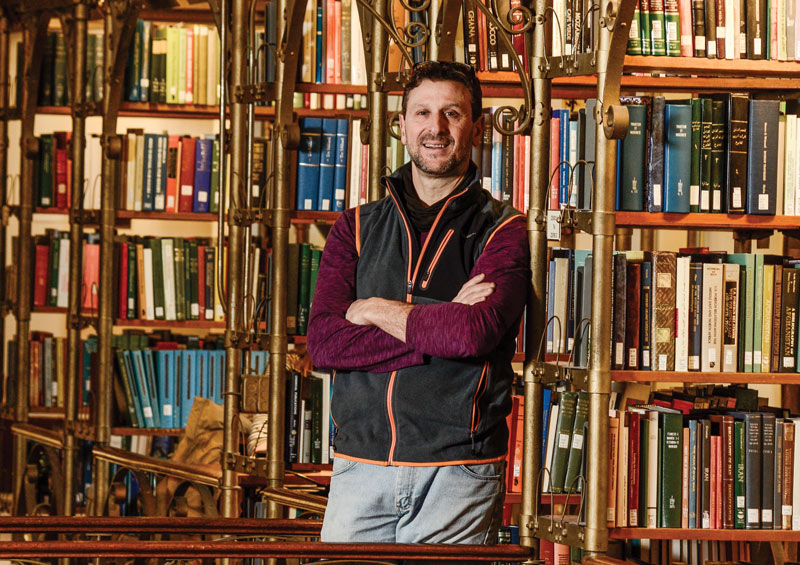
Rossi has taken his agronomic knowledge well past the golf industry, serving in consultant roles with New York City’s Central Park and the New York Yankees, among others. Photo by Heather Ainsworth
Rossi is not just one of golf’s great talkers. He has channeled his natural verbosity into a flood of relevant information.
“I try to maintain a strong problem-solving focus in the Extension program,” Rossi says, adding that he relies on what he calls a “just-in-time” delivery strategy. One example is ShortCUTT, a weekly subscriber-only e-newsletter sent to more than 3,000 turf managers.
“Obviously, you’ve got someone in Frank Rossi who is very knowledgeable and extremely passionate about his chosen subject, but more than that is his ability to articulate that knowledge in clear, understandable, laymen’s terms,” Mona says. “For people to understand on a scientific level, he can go deep, but he’s pretty remarkable in his ability to break down complicated concepts into simple language. That’s rare among academic types, who tend to have their own language. Frank has got that common touch.”
His protégé Woods may have put it best: “Frank’s not all show. You may think that when you see him waving his arms at some seminar — that he’s just putting on a show. But when you see him on a regular basis, work with him, you realize he’s also paying attention, remembering the issues, bringing someone else’s work into the discussion, contributing valuable insights, moving the discussion forward.
“All this tends gets people thinking, ‘Why am I doing it that way? Frank mentioned a guy in Florida who’s doing it this way ... Maybe I should try that.’ Ninety-nine percent of those who attend his seminars question what they are doing on account of him, and do a better job on account of him. He’s had a huge impact on the industry in that way.”
Hal Phillips is the managing director of golf and resorts for Mandarin Media, a public relations firm with offices in Portland, Maine; Park City, Utah; and Saigon, Vietnam. He is the former editor of Golf Course News.